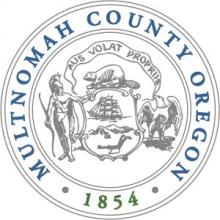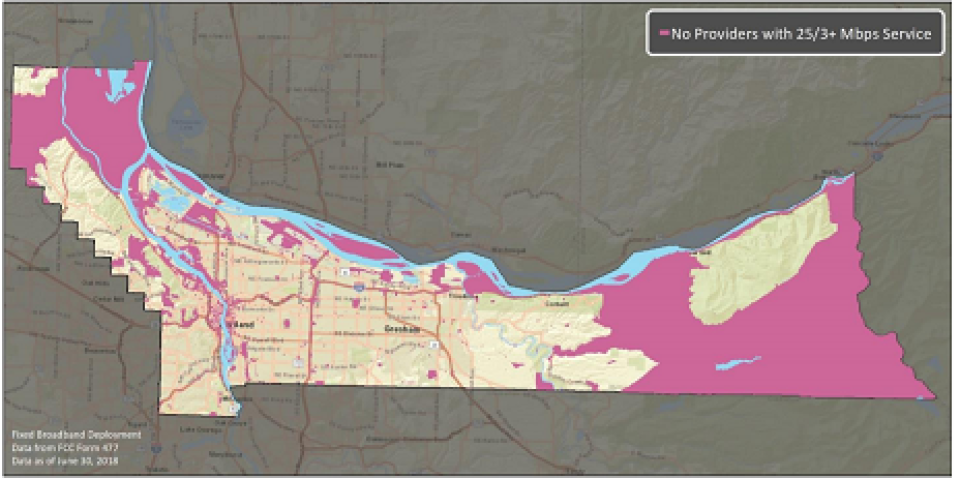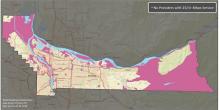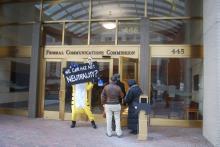
Along the banks of the Columbia River, Multnomah County (pop. 813,000), Oregon is considering a publicly owned Fiber-to-the-Home (FTTH) network after being handed a study more than a year in the making. The report estimates that a countywide network reaching every home, business, and farm in a five-city area would cost just shy of $970 million, and bring with it a wealth of savings and other benefits to the community it serves.
Origins
The study has its origins in a 2017 push initiated by an advocacy group called Municipal Broadband PDX which has sought more affordable and equitable Internet access in the region. In 2018, the County Board of Commissioners agreed that it should be explored and approved the funding of a study, with the city of Portland and Multnomah County each contributing $100,000 and the remaining towns of Fairview, Gresham, Troutdale, and Wood Village joining the effort to collectively contribute an additional $50,000 for funding. Over the next year, CTC Technology and Energy conducted a comprehensive survey, analysis, and evaluation, and the results were delivered at the end of September.

The report offers good news: the majority of residents in Multnomah County want a publicly built and operated FTTH network, and it would be economically viable to provide symmetrical gigabit service to as many of the more than 320,000 households as want it for $80/month. At a projected 36% take rate on a 4% bond over a 20-year period, the network would cost somewhere in the neighborhood of $966 million, depending on a host of local and market factors, some of which are fixed and others subject to change. It would see net positive income by the end of its fourth year of operation, and see a total of more than $54 million in positive net income by the end of its 20-year depreciation period (a standard model for fiber infrastructure, though they often last longer). These numbers change when adjusting the take rate and interest rate, but in the vast majority of scenarios, building a community owned FTTH network in Multnomah County is feasible.
Broadband in Multnomah County

Currently, Comcast and CenturyLink serve as the incumbent providers in Portland, with Comcast and Frontier serving some rural areas in the rest of the county. The CTC study concludes that while broadband is available to the vast majority of Multnomah, there are many unserved households and people remain, as a whole, unhappy with the cost, speed, reliability, and customer service of their current provider.
Only about 1% of the county (about 2,800 premises), according to the report, is completely unserved by wireline broadband at any speed, with these homes and businesses clustered in the northwest and southeast parts of the county. But when filtering for low-income households, that number jumps to 13%. The divide between those with fiber access is also large, with only 11% of households earning below $50,000/year with access compared to overall average of 17%. The County Board of Commissioners offers less rosy numbers for the city of Portland:
15 percent of Portland-area households do not have Internet access at home. For households earning under $30,000, that percentage goes up to 18 percent. For people who are over age 65, it’s 28 percent and for Hispanic households it’s 30 percent.
Countywide, 56% of the population has access to cable, with 17% each getting their broadband via DSL or fiber networks. Tellingly, only 40% of those surveyed for the report said the market provides high-speed broadband access at a price they can afford, with low-income households especially confined to access via DSL or mobile-only connections. One consideration not explored in the study is that 71% of responders report having more than four devices connected to their home network, which suggests that those favoring an all-fiber, affordable, publicly owned network sensitive to local needs will only increase over time.
Building a Network
The report concludes that the city of Portland would be the costliest to build in, at $200,000 per mile, with the rest of the county averaging $150,000 per mile. It calculates the cost per passing at $1,710 at a 35% take rate, and offers six forecasts for a community owned network with bond funding rates ranging from 2-6%, an increase/decrease in the capital needed to complete the project by 15%, and pricing tiers for gigabit service between $50 and $130. In the majority of scenarios, a community-owned network works for the county.

Fully half of those surveyed want the five Multnomah County municipalities to build a publicly owned fiber network, with 36% in favor of the resulting infrastructure being publicly operated as well. Both numbers speak to the dissatisfaction with existing service and lack of options currently available. The average broadband bill across the county currently sits at $71/month across DSL, cable, and fiber, though that accounts for download speeds ranging from less than 25 Mbps to gigabit.
Alternate Models
The study offers a number of alternatives to a FTTH network as well that consider different appetites for risk, capital expenditure, and deployment speed. The first and cheapest is a free, public wireless network aimed at communal spaces and getting students connected. Using more than 600 government buildings, schools, and libraries, a $2.8 million investment would expand current options and get thousands more connected quickly.
A more expensive fixed wireless solution is also outlined. For $36 million, CTC shows, the county could deploy a network targeted at those low-income households with poor or no connectivity options; the report concludes that with an approach that maximizes coverage while minimizing costs it could cover more than 13,0000 households, or 25% of all those with annual incomes less than $50,000 per year, also in relatively short order.
A handful of public-private partnerships are also modeled for consideration, which the report argues could mitigate risk, with case studies of municipally owned dark fiber and open access networks in Huntsville, Alabama, West Des Moines, Iowa, and elsewhere for the five Multnomah County partner cities to consider.
It remains unclear whether local officials in the county will move forward. There is no doubt that the report offers a wealth of survey data for local leaders to draw upon, and the conclusion that “Multnomah County residents trust public institutions more than private companies when it comes to delivering an essential utility fairly and effectively" is powerful. Whether the County Board of Commissioners will see it the same way, we don't know.
If you're looking for some light reading, see the full 282-page here [pdf] or read it below.










